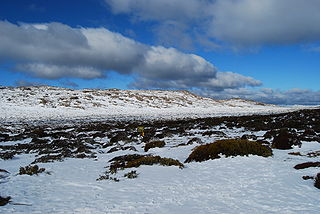
The Tanami Desert is a desert in northern Australia, situated in the Northern Territory and Western Australia.

The Northern Kimberley, an interim Australian bioregion, is located in the northern Kimberley region of Western Australia, comprising 8,420,100 hectares.

New England Tablelands, an interim Australian bioregion, is located mainly in New South Wales, comprising 3,002,213 hectares, of which 2,860,758 hectares or 95.23 per cent of the bioregion lies within New South Wales; and the residual within Queensland. This bioregion is one of the smaller bioregions in NSW, occupying 3.57 per cent of the state.

The Mitchell Grass Downs (MGD) is an IBRA biogeographic region, located in the Northern Territory and Queensland, which comprises an area of 33,468,761 hectares with eight subregions.

The Tasmanian Central Highlands is an interim Australian bioregion located in central highlands region of Tasmania, comprising 767,849 hectares.

The Tasmanian Northern Midlands is an interim Australian bioregion located in northern midlands region of Tasmania, comprising 415,445 hectares.

The Tasmanian Northern Slopes is an interim Australian bioregion located in the northern region of Tasmania, comprising 623,103 hectares.

Tasmanian West is an interim Australian bioregion located in the western region of Tasmania, comprising 1,565,077 hectares.

The Tasmanian South East is an interim Australian bioregion located in the south-eastern region of Tasmania, comprising 1,131,822 hectares.

The Tasmanian Southern Ranges is an interim Australian bioregion located in the southern region of Tasmania, comprising 757,228 hectares.

The Darwin Coastal, an IBRA bioregion, is located in the Northern Territory of Australia.

King is an interim Australian bioregion which includes King Island, the Hunter Islands, Robbins Island, and the north-western tip of Tasmania. The bioregion covers 425,567 hectares.

Ben Lomond is an interim Australian bioregion located in the north eastern region of Tasmania, comprising 657,500 hectares.

The Gulf Coastal, an interim Australian bioregion, is located in the Northern Territory, comprising 2,711,718 hectares.

Mount Isa Inlier, an interim Australian bioregion, is located in the Queensland, and comprises 6,778,263 hectares.
The Pacific Subtropical Islands is an interim Australian bioregion which includes Norfolk Island and Lord Howe Island. Its IBRA code is PSI.

Central Mackay Coast, an interim Australian bioregion, is located in Queensland, and comprises 1,464,208 hectares.

Cobar Peneplain, an interim Australian bioregion, is located in New South Wales, and comprises 7,385,346 hectares.

Tanami is an interim Australian bioregion, comprising 25,997,277 hectares in the Northern Territory and Western Australia. It is part of the Great Sandy-Tanami desert ecoregion.

The Bassian ecoregion is a biogeographic region of Australia's coastal and continental shelf waters. It includes the cold-temperate waters surrounding Tasmania, including the central Bass Strait between Tasmania and the southern Australian mainland. This ecoregion, designated in the Marine Ecoregions of the World system by the World Wildlife Fund (WWF), includes both the Bass Strait Shelf and Tasmanian Shelf provincial level bioregions from the Integrated Marine and Coastal Regionalisation of Australia (IMCRA) system.




















